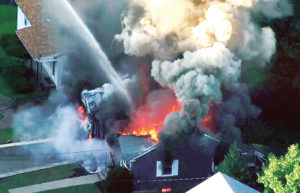Explosions in Boston. More than a gas leak?

In this image take from video provided by WCVB in Boston, flames consume the roof of a home in Lawrence, Mass, a suburb of Boston, Thursday, Sept. 13, 2018. Emergency crews are responding to what they believe is a series of gas explosions that have damaged homes across three communities north of Boston. (WCVB via AP)
Sept. 18, 2018:
Pressure before Massachusetts gas explosions was 12 times higher than normal.
Democratic U.S. Sens. Elizabeth Warren and Edward Markey sent the letter Monday seeking answers about the explosions from the heads of Columbia Gas.
(The company that serves the communities of Lawrence, Andover and North Andover, and NiSource, the parent company of Columbia Gas.)
“The pressure spike registered in a Columbia Gas control room in Ohio, the senators said in the letter, which requests a reply by Wednesday.
“We write to request that you provide us with information in order to help the American people understand why this terrible disaster occurred, whether the company was sufficiently prepared to respond to an incident of this magnitude, and how we can prevent any similar tragedy in the future,” the senators wrote.
Dozens of explosions and fires last Thursday killed one person and injured more than two dozen others. About 8,600 customers were affected, and many had to evacuate their homes for days and may have to go without gas service for weeks.
Sophisticated computer programs are used to evaluate the delivery capacity of the network and to ensure that all customers receive adequate supplies of gas at or above the minimum pressure level required by their gas appliances.
Distribution mains are interconnected in multiple grid patterns with strategically located shut-off valves. These valves minimize the need for customer disruption to service during maintenance operations and emergencies.
https://www.aga.org/natural-gas/delivery/how-does-the-natural-gas-delivery-system-work-/
Richard Clark on Hacking
Former U.S. National Coordinator for Security, Infrastructure Protection, and Counterterrorism
Sept. 14th: “They’re in our power grid.”
[Begin at 1:45]
The current state of international cooperation on cyber threats, including opportunities and challenges for coordination between government and industry on cyber issues.
[Washington Post]
BOSTON
NiSource Inc. is one of the largest fully regulated utility companies in the United States, serving approximately 3.5 million natural gas customers and 500,000 electric customers across seven states through its local Columbia Gas and NIPSCO brands. The company, based in Merrillville, Indiana, United States, has more than 8,000 employees.
In December 2011, the non-partisan organization Public Campaign criticized NiSource for spending $1.83 million on lobbying and not paying any taxes during 2008-2010, instead getting $227 million in tax rebates, despite making a profit of $1.4 billion, and increasing executive pay by 33% to $11.2 million in 2010 for its top 5 executives.[3] One rule NiSource, among other companies, benefitted from was a bonus depreciation rule that lowered the federal tax expense. NiSource stated, “This law, enacted by Congress, encouraged companies like NiSource to accelerate capital investments to spur economic recovery by permitting portions of these investments to be deducted at an accelerated rate. Only the timing of the deductions was changed, and not the amount that could be deducted. This means our income tax expense will likely be higher in the future.
[From Wikipedia]
Leave a Reply